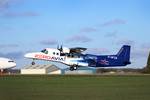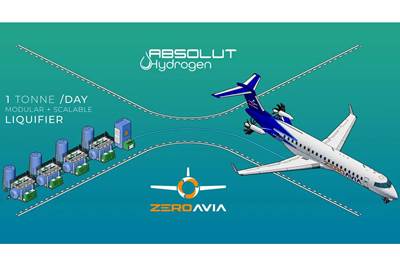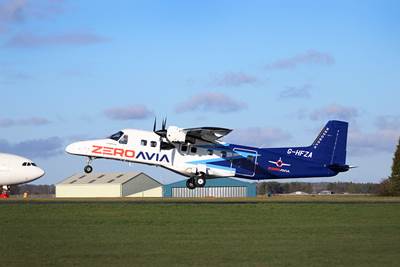ZeroAvia expands the reach of zero emissions flight technology
Electric motor technology from ZeroAvia for aviation applications is helping pave way for hydrogen-electric engines for Dash 8 and similar airframes.

Photo Credit: Getty Images
ZeroAvia (Hollister, Calif., U.S.) was supplied with a Dash 8 Q400 regional turboprop by Alaska Airlines (Seattle, Wash., U.S.) to be retrofitted with a hydrogen-electric propulsion system in an effort to expand the reach and applicability of zero emissions flight technology. The aircraft was formally handed over to ZeroAvia by Alaska Airlines at an event held at ZeroAvia’s Paine Field research and development site.
When Alaska Airlines’ regional carrier Horizon Air retired its Q400 fleet, it reserved one of the aircraft for research and development purposes to further advance zero emissions technology for the aviation industry. The aircraft was repainted with a special livery to highlight the mission of the partnership.
A multi-megawatt modular electric motor system in a 1.8 MW protoype configuration was also shown by ZeroAvia at the event. It was demonstrated with a propeller spin aboard the ZeroAvia’s 15-ton HyperTruck ground-test rig. Combined with higher temperature PEM fuel cells and advanced power electronics — both technologies that ZeroAvia is developing in-house — the electric motor technology is one of three building blocks for enabling commercially-relevant hydrogen fuel cell engines for larger aircraft.
"This is a great step forward in aviation innovation, to help create a new future of flight — right here at home,” says Alaska Airlines CEO Ben Minicucci. “Alaska Airlines has defined a five-part journey to achieve net zero carbon emissions long-term, but we can’t get there alone. New technologies are required to make that future possible, and we’re thrilled to partner with industry leader ZeroAvia to make new zero emissions options a reality.”
Aligning ZeroAvia’s powertrain with the Dash 8-400, also known as the Q400, airframe is intended to represent a commercially viable, zero-emission aircraft with fuel cell engine technology around five times more powerful than what has been demonstrated elsewhere.
“Demonstrating this size of aircraft in flight, powered entirely by novel propulsion, would have been unthinkable a few years ago,” says Val Miftakhov, founder and CEO of ZeroAvia. “Launching this program puts us on track for a test flight next year, and accelerates our progress toward the future of zero-emission flight for Alaska Airlines and for the world at large.”
ZeroAvia’s developments not only light the way for a potential flight of the Q400, but they also demonstrate progress toward certification of the ZA2000 propulsion system. In January 2023, ZeroAvia flew a retrofitted 19-seat aircraft with its prototype 600kW hydrogen-electric engine (ZA600). This followed the demonstration flight of a 250kW system in 2020, which at the time of flight was the world’s largest aircraft flown using a novel zero-emission power source.
ZeroAvia’s hydrogen-electric engine uses fuel cells to generate electricity from hydrogen fuel, before using that electricity to power electric motors which turn the aircraft propellers. The certifiable ZA2000 system will include ZeroAvia’s High Temperature PEM fuel cells and liquid hydrogen fuel storage, integral to delivering the necessary energy density for commercial operations of large regional turboprops. The company has already established an engineering partnership with De Havilland of Canada, the original manufacturer of the Dash 8 family of aircraft to enable exchange of data and expertise with the airframe.
In 2021, Alaska Airlines launched a partnership and invested in ZeroAvia to support the development of zero emissions propulsion technology for regional aircraft. As the fifth largest U.S. airline with a large regional network, Alaska has an opportunity to support the development of zero-emissions propulsion technology for regional aircraft. By establishing the viability of regional-sized aircraft, both companies plan to advance zero-emissions technology across the industry.
Related Content
The state of recycled carbon fiber
As the need for carbon fiber rises, can recycling fill the gap?
Read MoreMaterials & Processes: Fabrication methods
There are numerous methods for fabricating composite components. Selection of a method for a particular part, therefore, will depend on the materials, the part design and end-use or application. Here's a guide to selection.
Read MoreNovel dry tape for liquid molded composites
MTorres seeks to enable next-gen aircraft and open new markets for composites with low-cost, high-permeability tapes and versatile, high-speed production lines.
Read MoreCarbon fiber in pressure vessels for hydrogen
The emerging H2 economy drives tank development for aircraft, ships and gas transport.
Read MoreRead Next
ZeroAvia and Absolut Hydrogen partner to develop liquid hydrogen refueling infrastructure for aircraft operations
Partnership supports development of LH2-powered aircraft with up to 80 seats by 2027 and robust airport infrastructure.
Read MoreZeroAvia successfully flies hydrogen-electric Dornier 228 testbed aircraft
The 19-seat twin-engine aircraft took to the skies for the first time as part of the HyFlyer II project, moving ZeroAvia toward its 2025 targets and scaling the technology to larger airframes.
Read MoreCW’s 2024 Top Shops survey offers new approach to benchmarking
Respondents that complete the survey by April 30, 2024, have the chance to be recognized as an honoree.
Read More


























